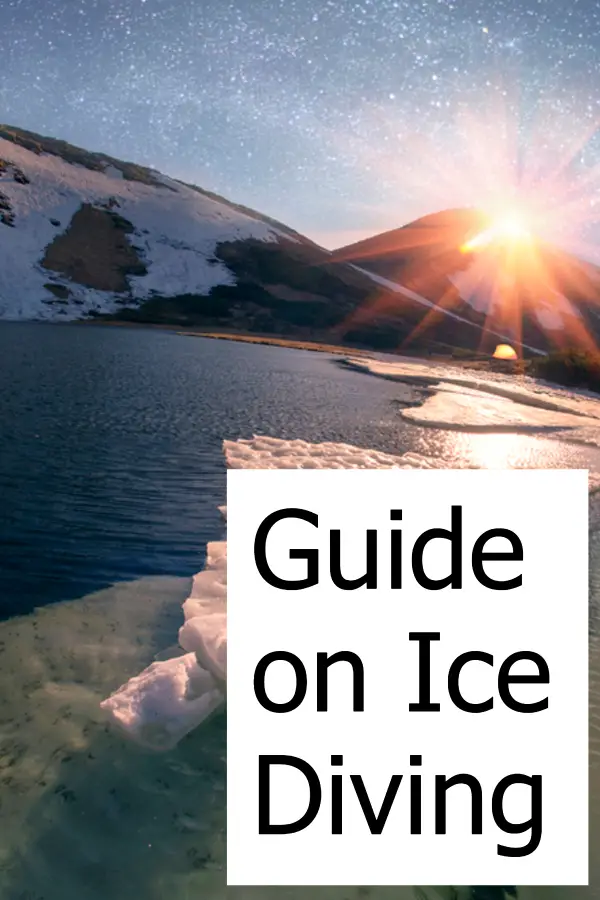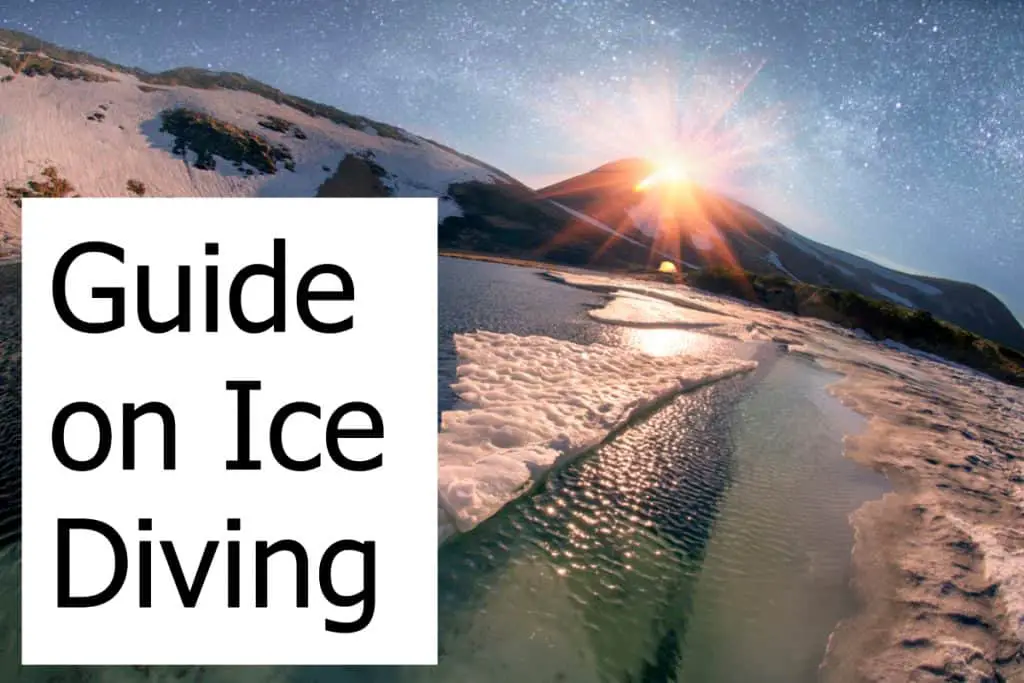Guide on Ice Diving – What you need to know!
Diving into a body of water during the peak of summer is one thing but what about doing it during the heart of winter and dive under ice?
Ice diving has become an intriguing option for divers and thrill-seekers aiming to understand the nuances of ice-cold water. Once the temperature drops, it becomes ripe for ice diving and this information guide is going to touch on the intricacies of it.
Let’s take a look at what lies ahead for those thinking of diving beneath a thick layer of ice for the first time.
What Is Ice Diving?
1) Definition of Ice Diving
Ice diving refers to the act of diving under a thick layer of ice. In general, a “dive site” is an area that allows divers to head underwater to take a look at what lies beneath. Of course, in the summer months, the dive site is left fully exposed and doesn’t have a barrier to entry. However, once the cold wintry months start to approach, a layer of ice starts to develop on the surface as water begins to freeze. It’s at this point when ice diving becomes a possibility based on where the broken layers are available.
Please note, ice diving is not the same as cold water diving and shouldn’t be confused about it. Coldwater diving refers to diving done when the temperature is low and the water is jittery cold but doesn’t have a top layer of ice. Ice diving requires the top layer of ice to be present – Why do Scuba Divers Dive Backwards into the Water?
In general, ice starts to develop once the temperature drops well below zero and the water temperatures cool down to around 40 degrees F or so. In most cases, this is the bare minimum and the water temperature starts to fall well below this number in places such as Antarctica.
Debriefing after a Dive – A Waste of Time or an Important Habit?
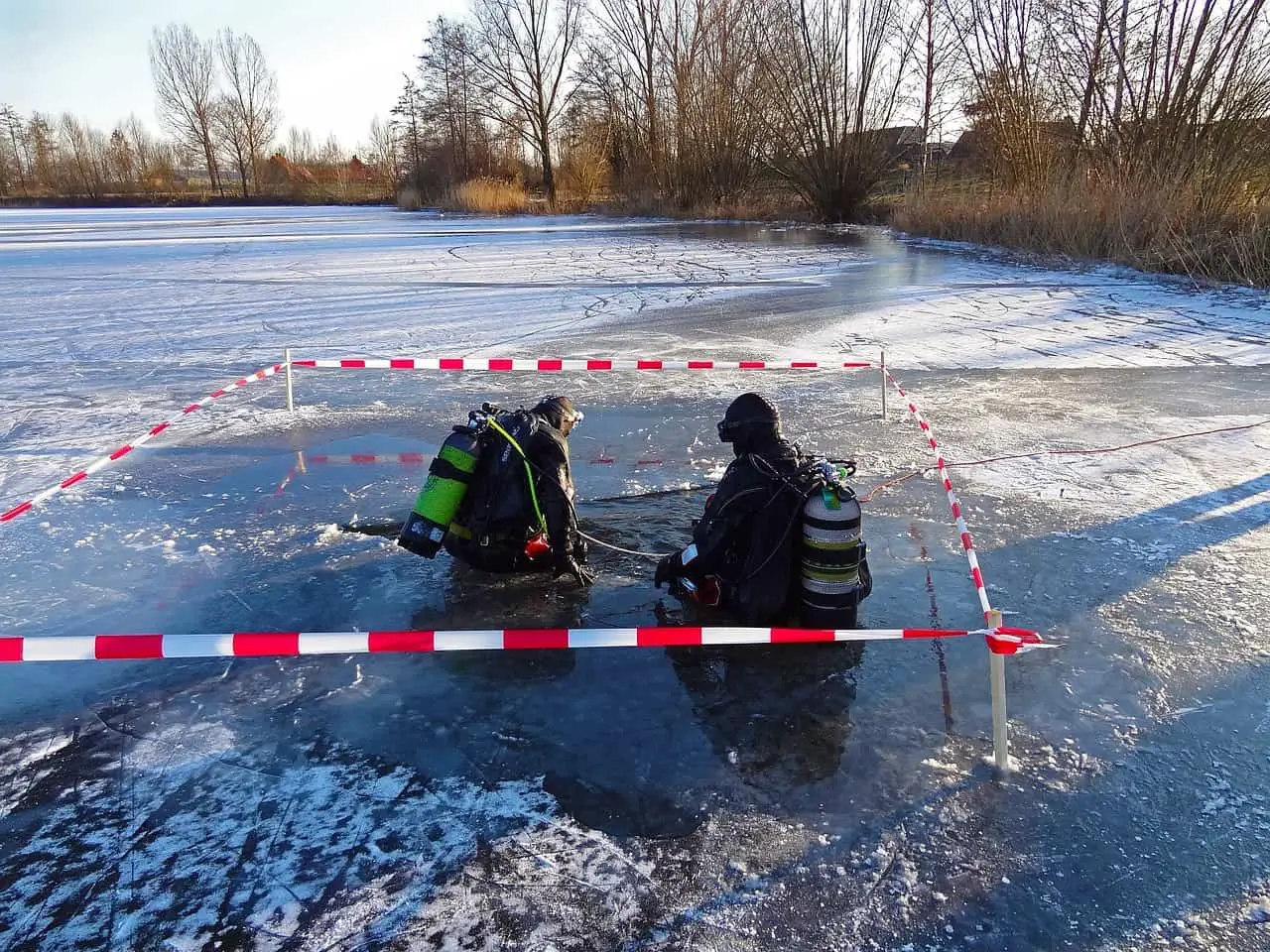
2) Who Does It?
Let’s move onto the next part of this question and that’s who would take the time to go ice diving?
Ice diving is an intriguing activity because it’s ideal for divers who want to experience something new (Swimming Backward – Something a Diver Should Be Able to Do?) and get a look at a dive site from a different perspective. The water tends to reveal different nuances when it has a frozen layer of ice making it a unique experience. Many researchers tend to head into these areas in order to get a deeper look into what transpires beneath the thick layer of ice. Most divers will go as a team (2-4 members) to make sure everyone is safe. With the four-member team, only one diver is supposed to “dive” and the others act as support actors in making sure the initial diver is safe from start to finish.
Ice diving is often seen as a moment to try something new and get a look at animals in their natural environment during a period most never do see them. It’s one thing to see a penguin on TV and another to see them live in action as they spend time in their natural frozen habitat.
What Gear Do You Need?
Ice diving is heavily reliant on the gear (take additional special consideration when you’re dealing with scuba gear for kids!) being used more than any other form of diving. This has a lot to do with the weather, water conditions, and how cold it can get as you dive deeper into the water – Can you dive with a cold? For those who are prepping for a dive, it is time to look at the gear necessary for the adventure.
1) Drysuit
A drysuit involves thick material used to maintain body temperature and ensure the skin is protected.
The type of drysuit being invested into doesn’t matter as long as the basics are maintained. It should be durable, thick, and easy to wear otherwise it might get in the way of your diving experience. To maximize the drysuit, it’s best to focus on using wool as a layer under the dry suit along with wool socks. This will give it the added value needed to stay safe and warm under the ice.
In some cases, it is possible to buy thick undergarments customized for ice diving but these are unnecessary in most cases.
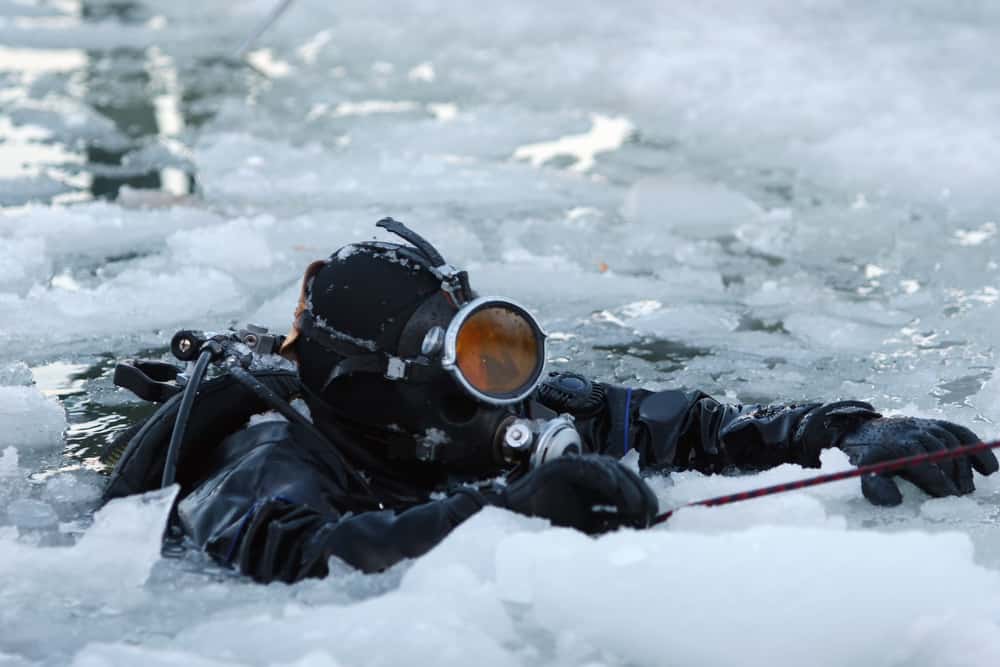
Scuba Gloves – Essential Facts You Need to Know About Diving Gloves
2) Dry/Neoprene Gloves
To go along with the drysuit, it’s highly recommended to buy neoprene gloves.
These gloves are designed to handle low temperatures and are going to ensure the fingers don’t go numb as soon as you hit the water. It’s better to seek specialized dry gloves for the task but neoprene gloves are often used as a solution because they’re budget-friendly.
In general, both will work well under the ice.
3) Full-Face Mask
How is the face going to be protected when you go ice diving?
To protect the face, it is best to look at a full-face mask (How to find the Best Full Face Dive Masks). The full-face mask is designed to eliminate skin exposure but this is a personal preference. It is ideal to stay as protected as possible and learn how to dive with the full-face mask in place.
It keeps the skin protected and ensures the ice-cold water doesn’t touch it at any point in your diving session – Advantages and Disadvantages of a Full-Face Scuba Diving Mask!
4) Neoprene Hood
Along with the gloves and mask, it is important to look at a dry hood or a neoprene hood.
The hood is going to protect the top of your head and the back of your neck. It shouldn’t get in the way of your dry seals and that is the most important requirement. If it doesn’t get in the way, it will be easier to dive and move your head around from side to side.
Some divers prefer to go with the dry hood since it isn’t tucked-in like the neoprene hood. This is a personal choice.
Divers are always told to practice with their equipment in a simulated session to get a gist of what they are going to face. This can make it easier to manage movement and not feel congested when it comes to the diving session. Being able to move is essential especially when the temperature drops.
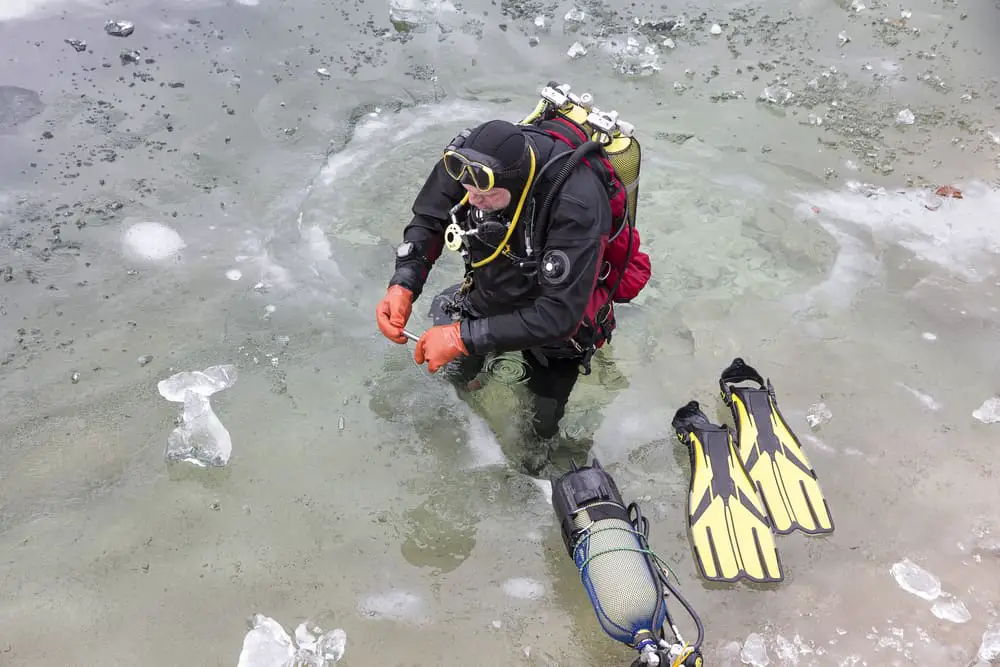
Framed vs Frameless Scuba Diving Mask – What are the Differences?
How Do You Penetrate The Ice?
Let’s move onto learning how to penetrate the ice for a successful ice diving session.
1) Snow Shovel
The first step to penetrate through is to shovel the snow.
In most areas, the snow is going to act as a top layer for the ice and has to be cleared off so you can gain access. To do this, get a couple of snow shovels and start clearing out the top layer as soon as possible. This is going to make it easier to saw through the ice.
2) Chainsaw
The hole is going to be made with the help of a chainsaw.
The goal is to find a spot that is ideal for diving and isn’t going to close up quickly. This is done with the help of a chainsaw or an ice saw.
3) Teammates
Yes, this is just as important as anything else for an ice diver.
Having teammates is the only way to make sure the entry and exit are smooth. It is easy to get trapped beneath the ice for those who don’t go in with 2-4 team members. The teammates are supposed to keep an eye out for new developments and act as a support system for the original diver and his or her dive buddy.
These are key requirements for those who are going to be entering the water. Penetrating the ice is all about finding a good dive site, clearing out the snow, and making a noteworthy entry hole to get into the water.
Other Considerations
There are additional considerations to make before moving forward with an ice diving session.
These considerations involve your safety and how you approach the task to make sure it doesn’t lead to issues in the water.
1) Safety
Let’s start with safety because it’s important to prepare well in advance.
Set up a plan and make sure it is targeting the right dive site. You want to go to an area that is well within the required temperature limit (40 degrees F (1-2 C)). It is also recommended to reduce the amount of time being spent in the water because of how cold it can get – Best Cold Water Regulators – Buying Guide and Reviews.
In general, the average dive session ends up being 30 minutes but it is best to reduce this to 15 minutes when the water is cold.
2) No Solo Sessions
Never consider ice diving on your own even if you have experience.
Ice diving has to be done with at least another dive buddy to make sure you’re safe from start to finish. There are several indicators of a potential hazard when you have a partner that can’t be seen when you’re on your own. Go with those who do have experience and it’ll be easier to dive in.
3) Cameras
Thinking about taking pictures when you are underwater?
There are divers who may be intrigued by the notion and want to take a few snaps while they are diving in. This is possible as long as the equipment is protected and there is light coming in from the hole. Otherwise, it will be dark underneath and that has to be accounted for.
4) Certificates
It is recommended to go ahead and receive an ice diving certificate from a certified association.
They will have instructors who are going to put you through simulated runs as a way to help understand what a diving session is going to entail. It can be a great experience on its own and can help you learn in the long term.
Diving or Snorkeling while Pregnant – What do you have to consider?
Why Should You Try Ice Diving?
Ice diving is a unique look (Check out all the details on wreck diving!) into the world of animals most people don’t get to see on a day-to-day basis.
Being able to spot a leopard seal in its natural habitat is one of those experiences that is impossible to match. It’s also an experience most people don’t get to have. In fact, many professional divers don’t get to have this experience.
It is also great for those who want to go somewhere nearby as there are cold regions on the planet ideal for ice diving. Look for one of these dive sites and plan a trip out for a quick diving session. It can be a great way to have fun and build memories that last a lifetime.
Another benefit most people don’t realize is the value of seeing animals clearly in colder water. The particles start moving slowly and that can make it easier to use external light to spot animals. These same animals would be difficult to spot in warmer conditions if you were to come in the summer.
Looking for warmer scuba destinations? Have a look at the best dive spots in the Caribbean!
